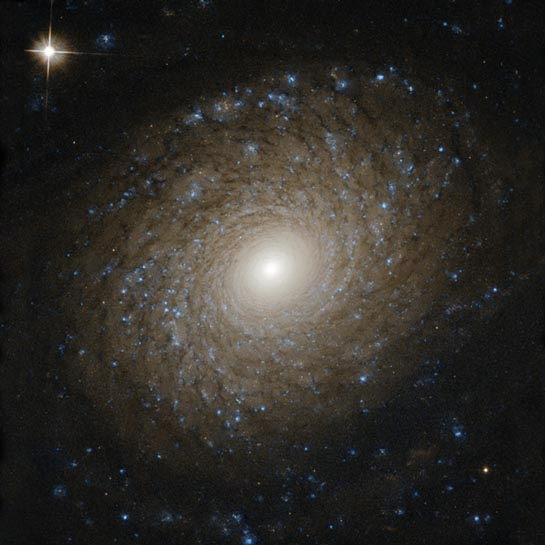
Spiral Galaxy
RA 9h 50m 22.05s Dec 72° 16' 43.71"
Ursa Major
70 million light years
10.4
7 x 6 arcmin
1.57 x 1.75 arcminutes
North is 47.9° right of vertical
ESA/Hubble & NASA, L. Ho
July 15, 2019
ABOUT
THIS IMAGE:
Galaxies come in many shapes and sizes. One of the key galaxy types we see in the Universe is the spiral galaxy, as demonstrated in an especially beautiful way by the subject of this Hubble Picture of the Week, NGC 2985. NGC 2985 lies roughly over 70 million light years from the Solar System in the constellation of Ursa Major (The Great Bear).
The intricate, near-perfect symmetry on display here reveals the incredible complexity of NGC 2985. Multiple tightly-wound spiral arms widen as they whorl outward from the galaxy’s bright core, slowly fading and dissipating until these majestic structures disappear into the emptiness of intergalactic space, bringing a beautiful end to their starry splendour.
Over aeons, spiral galaxies tend to run into other galaxies, often resulting in mergers. These coalescing events scramble the winding structures of the original galaxies, smoothing and rounding their shape. These objects possess a beauty all their own, distinct from the spiral galaxies from whence they came.
From Wikipedia:
NGC 2985 is a spiral galaxy located in the constellation Ursa Major. It is located at a distance of circa 70 million light years from Earth, which, given its apparent dimensions, means that NGC 2985 is about 95,000 light years across. It was discovered by William Herschel on April 3, 1785.
The galaxy is seen with an inclination of 37 degrees. The galaxy has a bright nucleus from which emanate multiple tightly wound spiral fragments. Numerous blue knots are visible at the galactic disk. At the outer part of the galaxy lies a massive spiral arm that forms a pseudoring that encircles the galaxy. The inner part of the galaxy, where active star formation has been observed, has been found to be unstable, contrary to the outer stable one. It has been suggested that the presence of molecular clouds accounts for the instability of the region.
The nucleus of NGC 2985 is active, and based on its spectrum has been categorized as a LINER. The most accepted theory for the activity source is the presence of an accretion disk around a supermassive black hole. The mass of the supermassive black hole at the center of NGC 2985 is estimated to be 160 million (108.2) M☉ (solar masses), based on stellar velocity dispersion. The velocity dispersion is anisotropic, and changes with the azimuth. The rotational speed of the galaxy at its effective radius is 222.9 ± 31.2 km/s.
NGC
2985 is the brightest member of a galaxy group known as the NGC 2985 group.
Other members of the group include NGC 3027, 25 arcminutes away. Other
nearby galaxies include NGC 3252, and NGC 3403.